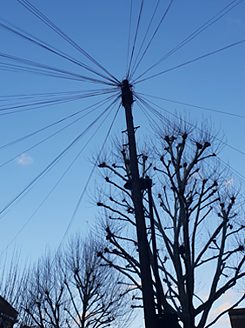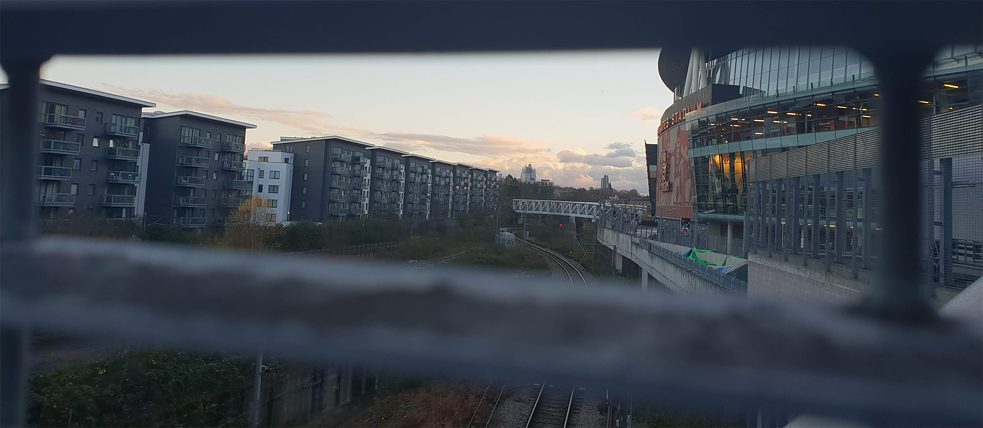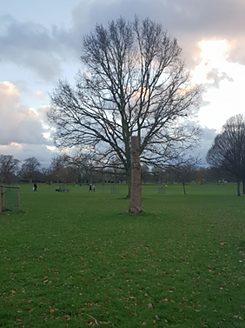Traces of Resistance
Part I: Holloway
If this was then, then you’d be here.
Tracing the source of the Hackney Brooke, one of London’s many underground rivers, the first part of the author’s notes tries to evoke the underlying geometry revealed by the hidden water path.22
The Hackney Brook, one of London’s many underground rivers, rises in more than one place. One of them is on Mercers Road, a small suburban street between Tufnell Park and Holloway Road.
23
A hollow way is a sunken lane; a road that is lower than the land on either side. It is not engineered but possibly of much greater age. There are different theories of how they may have been formed such as by erosion caused by water or traffic. In another theory, digging double banks established the boundaries between estates.
24
The origins of the district name Holloway are disputed. Besides referring to a sunken lane, the name might derive from Hallow – referring to the road’s past as a pilgrimage route.
25
I reach the source of Hackney Brook, somewhere between two identical suburban houses on Mercers Road. Silence in the neighbourhood, a fence overgrowing with ivy, a view into a garden behind the houses: Marshland.Google Maps: Search here.
Explore the area.
26
A few hundred metres South, the Holloway Prison just closed down, waiting to be turned into luxury condos and rendering-like green spaces with benches no one wants to sit on.Since 1903 a female-only prison, many suffragettes were imprisoned there:
Emily Davidson
Constance Markievicz
Charlotte Despard
Mary Richardson
Dora Montefiore
Hanna Sheehy-Skeffington
Ethel Smyth
Emmeline Pankhurst
Sylvia Pankhurst
During a hunger strike in 1912, they sang the anthem of the suffragette movement, the March of the Women, composed by Ethel Smyth with lyrics by Cicely Hamilton:
Shout, shout, up with your song!
Cry with the wind, for the dawn is breaking;
March, march, swing you along,
Wide blows our banner, and hope is waking
27
In the early 20th century, Sylvia Pankhurst and the Women’s Social and Political Union WSPU organised protests, rallies, and marches all over Britain, drawing tens of thousands of people at their demonstrations. Sylvia Pankhurst was imprisoned many times, endured force-feeding, long periods of hunger, thirst and sleep strikes in Holloway Prison.She wrote: We do not make beams from the hollow, decaying trunk of the fallen oak. We use the upsoaring tree in the full vigour of its sap.
28
A shop: Picture FramersOn lampposts, warnings: Criminals Beware. A new CCTV system
Fire Escape,
Keep Clear.
29
Holloway Road. Odeon Cinema. A pump in its basement keeps the water away. On the other side, Barclays Bank, where a Roman settlement by the Hackney Brook river was supposed to be. The city council says that »ground conditions in this area are sensitive«. Sunken lane.
30
Passing by construction sites:Site Safety
This is a hard hat area
High visibility jackets must be worn
Protective footwear must be worn
No admittance for unauthorised personnel
31
My feet surrender right in front of a small all-day breakfast place: The Rabbit Hole – follow the white rabbit. The river must be running under the shallow floor. Halfway into the full English breakfast, a group of exhausted-looking teenagers enters the bar. I’m going to fucking kill you, man. A fight with the owner unfolds, the customers look down into their plates, all of a sudden fixed on details they never saw before. The only girl in the group is a former waitress of the Rabbit Hole, her friends are here to demand her salary from the owner. He told them they could pick it up after sunset, but they want to go shopping now. A picture on the wall shows an electric post connecting houses in all directions. Avoiding any crossfire in the room, I start counting the wires. The radio plays Everyday is like Sunday von Morrissey:Trudging slowly over wet sand
Back to the bench where your clothes were stolen
This is the coastal town
That they forgot to close down
Armageddon, come Armageddon!
Come, Armageddon! Come!
Everyday is like Sunday
Everyday is silent and grey
32
Following the course of the Hackney Brook towards Arsenal, the Emirates Stadium, home of Arsenal F.C., appears between the wires that connect the rows of houses.
33
The football club Arsenal is founded in 1886 by David Danskin and fellow munition workers in the South East of London. It got its name from the Royal Arsenal complex in Woolwich where they worked. When they moved to Islington in 1913, the tube station is eventually renamed after the club itself, making it the only station in the UK directly named after a sports team.34
Posters in a tunnel: Grimes’ new album:We Appreciate Power
35
Follow the statues of Thierry Henry and Ken Friars around the stadium:Attention. This area is not suitable for Skateboarding / Cycling / Rollerblading / and/or similar activities and such activities are carried out at your own risk. Engaging in such activities in this area may be dangerous and could cause harm or injury to you or a third party.
36
In the late 90's, Arsenal explored the possibility of relocating and bought an industrial and waste disposal estate where they started building a new stadium in 2002. The former stadium around the corner at Highbury was turned into an apartment complex, Highbury Square. The new stadium is named Emirates like the airline, its main sponsor.37
At Clissold Park, two ponds mark the course of the brook, yet it is not the river that feeds the lakes anymore.A rose on the iron fence around the lakes,
two stones on the railing,
someone’s grave.
Picnics are welcome in the park. BBQs are not permitted.
38
Further down, a row of houses, copy paste, pastel colour palette.Firewall, windowless.
I relocate my path on Google maps, towards Abney Park, no indication of any further paths, information gaps, switch to Satellite mode: the deep dark forest, no light, no crack, no way in.
39
In the early 19th century, London grew rapidly and with it the amount of the dead it has to bury. In 1832 parliament passed a bill allowing for new private cemeteries. Within ten years, seven new cemeteries were built at the fringes of the city – »The Magnificent Seven«.One of them, Abney Park, was founded as a cemetery for dissenters, a non-denominational chapel at its centre. Beyond the city gates, a cemetery open to all, regardless of religious conviction, a sacred field of nonconformists: dissenting ministers and educationalist, Baptists, Methodists, Salvation Army ministers, Jews are buried in between plantings of this opaque urban forest; with no divisions between members of different faiths.
The cemetery was also founded as an arboretum with thousands of various plants. An alphabetical planting of tree species set out around the perimeter along with collections of oaks, thorns, pine and others within – the park as an encyclopaedia.
When Abney Park was abandoned in the 1970s, this setup sparked a burst of urban wilderness, so that when the Borough of Hackney took over the management of the site in the '80s, they decided to preserve the wildlife.
The cemeteries rosarium, once reflected in the – now destroyed – stain glassed windows of its chapel, contains over a thousand varieties of roses.
I think of the single rose of Clissold Park.
A small memorial records the civilian deaths during the Blitzkrieg.
40
Margery Lawrence writes during an air raid in October 1941:There is a monstrous garden in the sky
Nightly they sow it fresh. Nightly it springs,
Luridly splendid, towards the moon on high.
Red-poppy flares, and fire-bombs rosy-bright
Shell-bursts like hellborn sunflowers, gold and white
Lilies, long-stemmed, that search the heavens' height...
They tend it well, these gardeners on wings!
How rich these blossoms, hideously fair
Sprawling above the shuddering citadel
As though ablaze with laughter! Lord, how long
Must we behold them flower, ruthless, strong
Soaring like weeds the stricken worlds among
Triumphant, gay, these dreadful blooms of hell?
O give us back the garden that we knew
Silent and cool, where silver daisies lie,
The lovely stars! O garden purple-blue
Where Mary trailed her skirts amidst the dew
Of ageless planets, hand-in-hand with You
And Sleep and Peace walked with Eternity.....
But here I sit, and watch the night roll by.
There is a monstrous garden in the sky!
One of two known, unexploded bombs of the World War II, remaining in the Stoke Newington area, must be located somewhere in Abney Park.
41
Between 1854 and 1941, the London Necropolis Railway (LNR), founded to keep the diseases of the dead out of the city of the living, transported 200,000 corpses from Waterloo to a new cemetery in Surrey. Nothing remains of the LNR station after heavy bombardment from German bombers during World War II.42
The bus 76 to Waterloo passes by.43
I walk into Stoke Newington Common where the Hackney Brook defines its Northern limits (it is here where, by the river banks, builders found 200,000-year-old axes which are amongst the earliest human artefacts ever found in Britain).44
A flyer on a tree:
Found cat. Found on 2nd December in N16. Appeared to be not sure where home was but not sign of injury.
go back to Preface: From Hyde Park to Holloway
go to overview: Traces of Resistance


